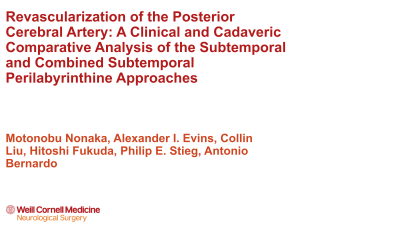Revascularization of the Posterior Cerebral Artery: A Clinical and Cadaveric Comparative Analysis of the Subtemporal and Combined Subtemporal Perilabyrinthine Approaches
Friday, April 21, 2023


Antonio Bernardo, MD
Professor of Neurosurgery
Weill Cornell Medicine, Neurological Surgery
New York, New York, United States
ePoster Presenter(s)
Introduction: Posterior circulation revascularization is essential for complex cerebral aneurysms that cannot be treated with endovascular interventions. Revascularization of the posterior cerebral artery (PCA) is particularly difficult due to the deep and narrow surgical corridor necessary for access. Several approaches have been previously proposed for PCA revascularization, but all remain technically challenging and could cause complications. We evaluate and assess the exposure afforded by a conventional subtemporal approach compared with combine subtemporal perilabyrinthine approaches.
Methods: Subtemporal approaches and subtemporal approaches combined with supralabyrinthine, supra- and retrolabyrinthine, and retrolabyrinthine pre- and retrosigmoid approaches were performed on 5 cadaveric heads (10 sides). All of the perilabyrinthine approaches were completed with incising of the tentorium. Exposure of the anterior and posterior aspects of the P2 segment of the PCA and the surgical maneuverability afforded by each approach was evaluated.
Results: The subtemporal approaches proved insufficient exposure of and surgical maneuverability around the P2 segment due to the presence of the tentorium superiorly and mastoid inferior. Addition of the supralabyrinthine mastoidectomy with tentorial resection improved exposure significantly. Addition of both supra- and retrolabyrinthine mastoidectomy offered good exposure but no clear advantage was obtained from the addition of the retrolabyrinthine drilling. Addition of the retrolabyrinthine pre- and retrosigmoid approach extended the surgical field inferiorly and posteriorly and expanded maneuverability.
Conclusion : The subtemporal approach alone is insufficient to adequately expose the P2 segment of the PCA. The addition of perilabyrinthine mastoid drilling and suprameatal dissection considerably improved exposure of the P2 segment, especially its posterior aspect. More extensive mastoid drilling is unnecessary for revascularization.
Methods: Subtemporal approaches and subtemporal approaches combined with supralabyrinthine, supra- and retrolabyrinthine, and retrolabyrinthine pre- and retrosigmoid approaches were performed on 5 cadaveric heads (10 sides). All of the perilabyrinthine approaches were completed with incising of the tentorium. Exposure of the anterior and posterior aspects of the P2 segment of the PCA and the surgical maneuverability afforded by each approach was evaluated.
Results: The subtemporal approaches proved insufficient exposure of and surgical maneuverability around the P2 segment due to the presence of the tentorium superiorly and mastoid inferior. Addition of the supralabyrinthine mastoidectomy with tentorial resection improved exposure significantly. Addition of both supra- and retrolabyrinthine mastoidectomy offered good exposure but no clear advantage was obtained from the addition of the retrolabyrinthine drilling. Addition of the retrolabyrinthine pre- and retrosigmoid approach extended the surgical field inferiorly and posteriorly and expanded maneuverability.
Conclusion : The subtemporal approach alone is insufficient to adequately expose the P2 segment of the PCA. The addition of perilabyrinthine mastoid drilling and suprameatal dissection considerably improved exposure of the P2 segment, especially its posterior aspect. More extensive mastoid drilling is unnecessary for revascularization.
